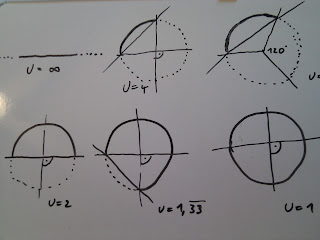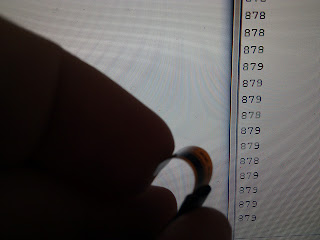While the company appears to focus on custom design, they produce standard sensors in three sizes, 3", 2" and 1". The actual variable resistor within the sensor is a bit shorter. Check the image for approximate actual measures:
Other flex sensors I had previously worked with where quite noisy and corse. Also they where usually pressure sensitive as well which in some cases can confuse readings. Another thing which I was sort of afraid of was that they had some type of memory, similar to the conductive polymere I have been working with.
I started playing with the three inch sensor. This is what I figured out:
- The signal is as clean as I would expect from a high quality potentiometer
- Using a voltage divider by Phidgets and an Arduino Duemillenove I was able to get a resolution of 800 points
- There is a slight memory effect. If the sensor is bent very strongly it does not go back to baseline
- The sensor is not strictly biderectional as about 80% of the possible readings are produced by flexing it in one direction. However there is enough resolution to do coarse bidirectional readings.
I decided to figure out the sensitivity at different levels of flexion (is that a word?) and came up with a chart that I wanted to test:
(U --> Umfang --> Circumference)
Basically I am using the sensors length as a measure and am wrapping it around an object 4 times, 3 times, 2 times and identical to the sensors length. That corresponds to distances of ∞, 2.26, 2.1, 0.777 & 0 inches (I dident do 1,33)
I used a phidgets voltage divider set to 27.4k and the analogue in of my Arduino for these measurements. These are the values I got:
- Baseline ~ 725 when first connected, 710 after beeing bent strongly and released again
- 4x -- ~ 550
- 3x -- ~ 450
- 2x -- ~ 290
- Circle ~ 80
- 3" -- ~ 710
- 2.5" -- ~ 420
- 2" -- ~ 280
- 1.5" -- ~ 180
- 1" -- ~ 120
- 0.5" -- ~ 80
I measured it by marking the distance I want to bend (or flex) to and holding one end tight moving the other end to that mark:
The sensor is glued to a strip of plastic for a more rigid setup. This is to minimize rotation or uneven flexing of the sensor. Which brings me to the main drawback of the 3" sensor: As it is so long, the flexing can happen at different places and it is also prone to rotate, which severely influences the readings. For very precise sensing, it may be of benefit to use shorter sensors.
Here are some images of the 3" sensor in action:
The 2" sensor seems easyer to work with than the 3" sensor, as it is less prone to multiple bends or rotations which give readings which are hard to interpret. My favorite, was the 1" sensor. To be honest that one really surprised me. I got the largest range of readings from it, and becouse of its small size, the readings are very clear (its almost inpossible to bend it in two different ways at the same time, and it is really easy to avoid rotation.) here are some images of the 1" sensor in action:


























where did you buy them?
AntwortenLöschenyou need to order them directly from the company: http://www.flexpoint.com/
AntwortenLöschenHave you tested the consistency of its voltage (or resistance) value readings across different units? Did they produce the same reading range?
AntwortenLöschenNo problems with small orders. Sensors are consistent across different units.
AntwortenLöschenIf you order, I recommend getting the bidirectional version. For some reason when providing samples and initial quotes they always pull out the one I played with in that post. They have a bidirectional version which is much nicer to work with, as it does not require a voltage divider and has a symmetrical response to bending in either direction.